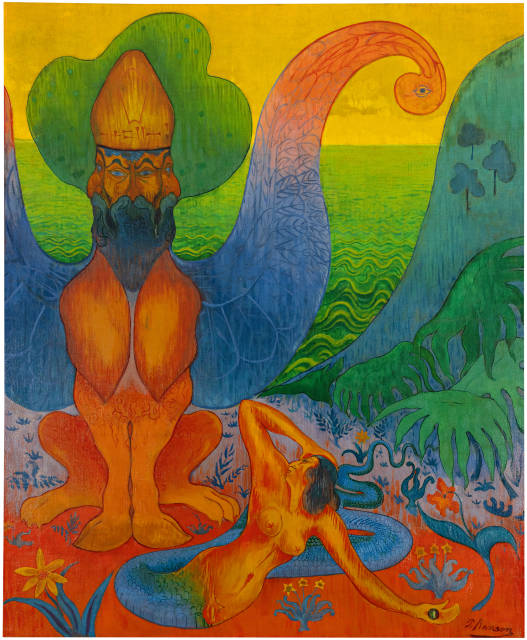- EN
Log in
- Live Auctions
- Past auctions
- More
- Gallery
- Art Dealing
- Publishing
- Kornfeld today
- The Story of Kornfeld
- Information



Limoges 1864 - 1909 Paris
1891
Oil on canvas
92x73 cm
Signed "P. Ranson" by the artist in oil lower right. Signed twice on the reverse, titled "Nabi" in Arabic and dated "91"
Brigitte Ranson Bitker/Gilles Genty, Paul Ranson, Catalogue raisonné, Paris 1999, no. 62, ill. 36, p. 111
Collection Auguste Cazalis
Private collection France
Auction Piasa, Paris, 15 June 2005, lot 9, probably acquired there by
Gallery Hopkins - Custot, Paris, acquired there in 2008 by
Private collection Germany
Charles Morice, Paul Ranson, in: Mercure de France, 15 February 1906, p. 608
Paris 1906, Galerie Druet, Paul Ranson, cat. no. 12
Saint-Germain-en-Laye 1997/1998, Musée Maurice Denis, Paul Ranson, cat. no. 18
Saint-Germain en Laye 2009/2010, Musée/Jardin Maurice Denis, Paul Élie Ranson, Fantasmes et Sortilèges
In very good condition and fresh in colour
Paul Ranson was one of the representatives of the "Nabis" artists' association, a group of young art students from the Académie Julian founded in Paris in 1888/1889. "Nabis" is derived from Hebrew and means prophet. The young artists, including Pierre Bonnard, Maurice Denis, Paul Sérusier, Félix Vallotton and Édouard Vuillard, to name but a few, saw themselves as "prophets" of a new art. The artists of the group, who were classified as Post-Impressionists, worked with a new colour scheme and a new pictorial structure, often with references to Symbolism. Auguste Cazalis was a member of the group, and he or Henri Cazalis are also said to have given the movement its name.
The painting offered here is of great importance, as the name "Nabis" can even be found on the back of the painting in Arabic script. Shortly after its creation, Ranson gave the painting to Cazalis. The hippogriff is a mythical creature with the head, wings and forelegs of an eagle and the body of a horse, made famous in the 19th century by Honoré de Balzac theosophical novel "Séraphita" , published in 1834. Ranson probably interweaves various myths in his picture, such as the story of Perseus and Andromeda, Roger and Angelica (cf. lot 211, Redon) or the medieval legend of Melusine, a woman in dragon/snake form who unites with a knight. Interestingly, a similar myth can also be found in Japan in the story of Princess Toyotama. Ranson, who was not only interested in ancient and medieval myths but was also influenced by Japonism, is likely to have created an amalgamation of different narrative strands in "Hippogriffe".
It is a very symbolically charged picture, with the winged mythical beast sitting stoically on the left and a woman with a serpent's body lolling at the lower edge of the picture. The scene is set in an almost surreal landscape. Ranson adds to the theosophical significance by depicting the mythical creature's head as a three-faced Brahma and painting an eye on one of the wings. "Hippogriffe" is an important, very mysterious and symbolic Nabi work.
1891
Öl auf Leinwand
92x73 cm
Unten rechts vom Künstler in Öl signiert "P. Ranson". Rückseitig doppelt signiert, in Arabisch betitelt "Nabi" und "91" datiert
Brigitte Ranson Bitker/Gilles Genty, Paul Ranson, Catalogue raisonné, Paris 1999,
Slg. Auguste Cazalis
Privatsammlung Frankreich
Auktion Piasa, Paris, 15. Juni 2005, Los 9, wohl dort erworben von
Galerie Hopkins - Custot, Paris, dort 2008 erworben von
Privatsammlung Deutschland
Charles Morice, Paul Ranson, in: Mercure de France, 15. Februar 1906,
Paris 1906, Galerie Druet, Paul Ranson,
Saint-Germain-en-Laye 1997/1998, Musée Maurice Denis, Paul Ranson,
Saint-Germain en Laye 2009/2010, Musée/Jardin Maurice Denis, Paul Élie Ranson, Fantasmes et Sortilèges
Farbfrisch und in sehr guter Erhaltung.
Paul Ranson war einer der Vertreter der Künstlervereinigung der "Nabis", einer 1888/1889 in Paris gegründeten Gruppe junger Kunststudenten der Académie Julian. "Nabis" leitet sich aus dem Hebräischen ab und bedeutet Prophet. Die jungen Künstler, unter ihnen auch Pierre Bonnard, Maurice Denis, Paul Sérusier, Félix Vallotton und Édouard Vuillard, um nur einige zu nennen, verstanden sich als "Propheten" einer neuen Kunst. Die dem Post-Impressionismus zugerechneten Künstler der Gruppe arbeiteten mit einer neuen Farbigkeit und einem neuen Bildaufbau, oft mit Bezügen zum Symbolismus. Auguste Cazalis gehörte mit zur Gruppe, er oder Henri Cazalis sollen der Bewegung auch den Namen gegeben haben.
Das hier angebotene Gemälde ist von grösster Wichtigkeit, da der Name "Nabis" sogar auf der Rückseite des Bildes in arabischer Schrift zu finden ist. Kurz nach seiner Entstehung schenkte Ranson das Gemälde Cazalis. Der Hippogreif ist ein Fabelwesen mit dem Kopf, den Flügeln und den Vorderbeinen eines Adlers und dem Körper eines Pferdes, das im 19. Jahrhundert vor allem durch den 1834 veröffentlichten, theosophischen Roman "Séraphita" von Honoré de Balzac bekannt wurde. Ranson verwebt in seinem Bild wohl verschiedene Mythen, etwa die Geschichte von Perseus und Andromeda, Roger und Angelica (Vgl. Los 211, Redon) oder die mittelalterliche Sage von Melusine, einer Frau in Drachen-/Schlangengestalt, die sich mit einem Ritter verbindet. Interessanterweise findet sich ein ähnlicher Mythos auch in Japan in der Geschichte der Prinzessin Toyotama. Ranson, der sich nicht nur für antike und mittelalterliche Mythen interessierte, sondern auch vom Japanismus beeinflusst war, dürfte mit "Hippogriffe" ein Amalgam verschiedener Erzählstränge geschaffen haben.
Es ist ein sehr symbolhaft aufgeladenes Bild, stoisch sitzt links das geflügelte Fabeltier, am unteren Bildrand räkelt sich eine Frau mit Schlangenleib. Die Szene spielt in einer fast surrealen Landschaft. Ranson erhöht die theosophische Bedeutung zusätzlich, indem er den Kopf des Fabelwesens als dreigesichtigen Brahma darstellt und auf einen der Flügel ein Auge malt. "Hippogriffe" ist ein wichtiges, sehr geheimnisvolles und symbolhaftes Nabis-Werk.
| Switzerland | CHF | Individual offer |
| Europe | CHF | Individual offer |
| Overseas | CHF | Individual offer |




